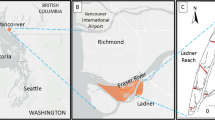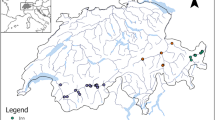Abstract
In the literature of salt marsh ecology, it remains challenging to determine whether vegetation dynamics in different communities are convergent toward a common structure controlled by the surrounding environmental conditions, or divergent contingent upon disturbance histories and variations in the order and timing of species arrivals. Based on the survey of species composition in a Danish salt marsh between 2006 and 2013, we show that the answer depends on which level of organization is being considered. At the level of individual plots (2 m2), each plot exhibited a distinct pathway of compositional changes from one another (i.e., divergence), within the ordination diagram constructed by nonmetric multidimensional scaling (NMDS). When these plots were aggregated into vegetation groups classified by a hierarchical cluster analysis, each group drifted with no particular order in the NMDS space until 2012, but, in 2013, finally converged toward the initial state of 2006. These findings indicate that group-level convergent and plot level diversifying processes operate simultaneously in salt marshes, making overall vegetation dynamics both deterministic and historically contingent, respectively.





Similar content being viewed by others
References
Bakker, J. P., H. Olff, J. H. Willems & M. Zobel, 1996. Why do we need permanent plots in the study of long-term vegetation dynamics? Journal of Vegetation Science 7: 147–156.
Bakker, J. P., J. de Leeuw, K. S. Dijkema, P. C. Leendertse, H. H. T. Prins & J. Rozema, 1993. Salt marshes along the coast of the Netherlands. Hydrobiologia 265: 73–95.
Bartholdy, J., C. Christiansen & H. Kunzendorf, 2004. Long term variations in backbarrier salt marsh deposition on the Skallingen peninsula - the Danish Wadden Sea. Marine Geology 203: 1–21.
Bartholdy, J., J. B. T. Pedersen & A. T. Bartholdy, 2010a. Autocompaction in shallow silty salt marsh clay. Sedimentary Geology 223: 310–319.
Bartholdy, A. T., J. Bartholdy & A. Kroon, 2010b. Salt marsh stability and patterns of sedimentation across a backbarrier platform. Marine Geology 278: 31–42.
Bazzaz, F. A., 1996. Plants in Changing Environments: Linking Physiological, Population and Community Ecology. Cambridge University Press, Cambridge.
Beeftink, W. G., 1987. Vegetation responses to changes in tidal inundation of salt marshes. In van Andel, J., J. P. Bakker & R. W. Snaydon (eds), Disturbance in Grasslands. Dr. W. Junk Publishers, Dordrecht, The Netherlands, pp. 97–117.
Belyea, L. R. & J. Lancaster, 1999. Assembly rules within a contingent ecology. Oikos 86: 402–416.
Bertness, M. D., L. Gough & S. W. Shumway, 1992. Salt tolerance and the distribution of fugitive salt marsh plants. Ecology 73: 1842–1851.
Bos, D., J. P. Bakker, Y. de Vries & S. van Lieshout, 2002. Long-term vegetation changes in experimentally grazed and ungrazed back-barrier marshes in the Wadden Sea. Applied Vegetation Science 5: 45–54.
Chase, J. M., 2003. Community assembly: when should history matter? Oecologia 136: 489–498.
Clements, F. E., 1916. Plant Succession: An Analysis of the Development of Vegetation. Carnegie Institution of Washington, Washington, D.C.
Collins, S. L., S. M. Glenn & D. J. Gibson, 1995. Experimental analysis of intermediate disturbance and initial floristic composition: decoupling cause and effect. Ecology 76: 486–492.
Cramer, W. & H. Hytteborn, 1987. The separation of fluctuation and long-term change in vegetation dynamics of a rising seashore. Plant Ecology 69: 157–167.
Davy, A. J., M. J. H. Brown, H. L. Mossman & A. Grant, 2011. Colonization of a newly developing salt marsh: disentangling independent effects of elevation and redox potential on halophytes. Journal of Ecology 99: 1350–1357.
de Leeuw, J., L. P. Apon, P. M. J. Herman, W. de Munck & W. G. Beeftink, 1994. The response of salt marsh vegetation to tidal reduction caused by the Oosterschelde storm-surge barrier. Hydrobiologia 282(283): 335–353.
del Moral, R., 2007. Limits to convergence of vegetation during early primary succession. Journal of Vegetation Science 18: 479–488.
Diamond, J. M., 1975. Assembly of species communities. In Cody, M. L. & J. M. Diamond (eds), Ecology and Evolution of Communities. Harvard University Press, Cambridge, MA: 342–444.
Díaz, S., M. Cabido & F. Casanoves, 1999. Functional implications of trait-environmental linkages in plant communities. In Weiher, E. & P. A. Keddy (eds), Ecological Assembly Rules: Perspectives, Advances, Retreats. Cambridge University Press, Cambridge: 338–362.
Dufrêne, M. & P. Legendre, 1997. Species assemblages and indicator species: the need for a flexible asymmetrical approach. Ecological Monographs 67: 345–366.
Fargione, J., C. S. Brown & D. Tilman, 2003. Community assembly and invasion: an experimental test of neutral versus niche processes. Proceedings of the National Academy of Sciences of the United States of America 100: 8916–8920.
Fox, B. J., 1987. Species assembly and the evolution of community structure. Evolutionary Ecology 1: 201–213.
Fukami, T., T. M. Bezemer, S. R. Mortimer & W. H. van der Putten, 2005. Species divergence and trait convergence in experimental plant community assembly. Ecology Letters 8: 1283–1290.
Gleason, H. A., 1927. Further views on the succession-concept. Ecology 8: 299–326.
Grime, J. P., 2006. Trait convergence and trait divergence in herbaceous plant communities: mechanisms and consequences. Journal of Vegetation Science 17: 255–260.
He, Q., F. Chen, B. Cui & Y. An, 2012. Multi-scale segregations and edaphic determinants of marsh plant communities in a western Pacific estuary. Hydrobiologia 696: 171–183.
Houseman, G. R., G. G. Mittelbach, H. L. Reynolds & K. L. Gross, 2008. Perturbations alter community convergence, divergence, and formation of multiple community states. Ecology 89: 2172–2180.
Inouye, R. S. & D. Tilman, 1995. Convergence and divergence of old-field vegetation after 11 year of nitrogen addition. Ecology 76: 1872–1887.
Kahmen, S. & P. Poschlod, 2004. Plant functional trait responses to grassland succession over 25 years. Journal of Vegetation Science 15: 21–32.
Kim, D., 2012. Biogeomorphic feedbacks drive dynamics of vegetation–landform complex in a coastal riparian system. Ecosphere 3: 74. doi:10.1890/ES12-00028.1.
Kim, D., 2014. Rates of vegetation dynamics along elevation gradients in a backbarrier salt marsh of the Danish Wadden Sea. Estuaries and Coasts 37: 610–620.
Kim, D., D. M. Cairns & J. Bartholdy, 2010. Environmental controls on multiscale spatial patterns of salt marsh vegetation. Physical Geography 31: 58–78.
Kim, D., D. M. Cairns & J. Bartholdy, 2011. Wind-driven sea-level variation influences dynamics of salt marsh vegetation. Annals of the Association of American Geographers 101: 231–248.
Kim, D., D. M. Cairns, J. Bartholdy & C. L. S. Morgan, 2012. Scale-dependent correspondence of floristic and edaphic gradients across salt marsh creeks. Annals of the Association of American Geographers 102: 276–294.
Kim, D., D. M. Cairns & J. Bartholdy, 2013. Tidal creek morphology and sediment type influence spatial trends in salt marsh vegetation. The Professional Geographer 65: 544–560.
Kirwan, M. L., G. R. Guntenspergen, A. D’Alpaos, J. T. Morris, S. M. Mudd & S. Temmerman, 2010. Limits on the adaptability of coastal marshes to rising sea level. Geophysical Research Letters. doi:10.1029/2010GL045489.
Law, R. & R. D. Morton, 1993. Alternative permanent states of ecological communities. Ecology 74: 1347–1361.
Leendertse, P. C., A. J. M. Roozen & J. Rozema, 1997. Long-term changes (1953–1990) in the salt marsh vegetation at the Boschplaat on Terschelling in relation to sedimentation and flooding. Plant Ecology 132: 49–58.
Lepš, J. & M. Rejmánek, 1991. Convergence or divergence: what should we expect from vegetation succession? Oikos 62: 261–264.
Levin, S. A., 1992. The problem of pattern and scale in ecology. Ecology 73: 1943–1967.
Lockwood, J. L., 1997. An alternative guide to succession: assembly rules offer guide to restoration efforts. Restoration Ecology 15: 45–50.
Matthews, J. W. & G. Spyreas, 2010. Convergence and divergence in plant community trajectories as a framework for monitoring wetland restoration progress. Journal of Applied Ecology 47: 1128–1136.
McCune, B. & T. F. H. Allen, 1985. Will similar forests develop on similar sites? Canadian Journal of Botany 63: 367–376.
McCune, B. & J. B. Grace, 2002. Analysis of Ecological Communities. MjM Software Design, Gleneden Beach, OR.
Morris, J. T. & A. Jensen, 1998. The carbon balance of grazed and non-grazed Spartina anglica saltmarshes at Skallingen, Denmark. Journal of Ecology 86: 229–242.
Morris, J. T., P. V. Sundareshwar, C. T. Nietch, B. Kjerfve & D. R. Cahoon, 2002. Responses of coastal wetlands to rising sea level. Ecology 83: 2869–2877.
Mossman, H. L., A. J. Davy & A. Grant, 2012. Quantifying local variation in tidal regime using depth-logging fish tags. Estuarine, Coastal and Shelf Science 96: 122–128.
Olff, H., J. de Leeuw, J. P. Bakker, R. J. Platerink, H. J. van Wijnen & W. de Munck, 1997. Vegetation succession and herbivory in a salt marsh: changes induced by sea level rise and silt deposition along an elevational gradient. Journal of Ecology 85: 799–814.
Pennings, S. C. & C. L. Richards, 1998. Effects of wrack burial in salt-stressed habitats: Batis maritima in a southwest Atlantic salt marsh. Ecography 21: 630–638.
Roman, C. T., W. A. Niering & R. S. Warren, 1984. Salt marsh vegetation change in response to tidal restriction. Environmental Management 8: 141–150.
Rupprecht, F., A. Wanner, M. Stock & K. Jensen, 2015. Succession in salt marshes – large-scale and long-term patterns after abandonment of grazing and drainage. Applied Vegetation Science 18: 86–98.
Rydin, H. & S. O. Borgegård, 1988. Primary succession over 60 years on hundred-year old islets in Lake Hjälmaren, Sweden. Plant Ecology 77: 159–168.
Samuels, C. L. & J. A. Drake, 1997. Divergent perspectives on community divergence. Trends in Ecology and Evolution 12: 427–432.
Schröder, H. K., K. Kiehl & M. Stock, 2002. Directional and non-directional vegetation changes in a temperate salt marsh in relation to biotic and abiotic factors. Applied Vegetation Science 5: 33–44.
Temperton, V. M., R. J. Hobbs, T. Nuttle & S. Halle, 2004. Assembly Rules and Restoration Ecology: Bridging the Gap between Theory and Practice. Island Press, Washington, D.C.
Tind, K., 2003. Danmarks Flora. Gyldendal, Copenhagen.
Wanner, A., S. Suchrow, K. Kiehl, W. Meyer, N. Pohlmann, M. Stock & K. Jensen, 2014. Scale matters: Impact of management regime on plant species richness and vegetation type diversity in Wadden Sea salt marshes. Agriculture, Ecosystems & Environment 182: 69–79.
Warren, R. S. & W. A. Niering, 1993. Vegetation change on a northeast tidal marsh: interaction of sea-level rise and marsh accretion. Ecology 74: 96–103.
Watkins, A. J. & J. B. Wilson, 2003. Local texture convergence: a new approach to seeking assembly rules. Oikos 102: 525–532.
Weiher, E. & P. A. Keddy, 1999. Ecological Assembly Rules: Perspectives, Advances, Retreats. Cambridge University Press, Cambridge.
Weiher, E., G. D. P. Clarke & P. A. Keddy, 1998. Community assembly rules, morphological dispersion, and the coexistence of plant species. Oikos 81: 309–322.
Wilson, J. B., 1999. Assembly rules in plant communities. In Weiher, E. & P. A. Keddy (eds), Ecological Assembly Rules: Perspectives, Advances, Retreats. Cambridge University Press, Cambridge: 130–164.
Wilson, J. B. & R. J. Whittaker, 1995. Assembly rules demonstrated in a saltmarsh community. Journal of Ecology 83: 801–807.
Wishart, D., 1969. An algorithm for hierarchical classifications. Biometrics 25: 165–170.
Acknowledgments
This research was partly supported by a National Science Foundation Geography and Regional Science Doctoral Dissertation Research Improvement Grant (No. 0825753) and Danish Agency for Science, Technology and Innovation, FNU Grant 272-07-0431. Thanks are due to Catherine Brereton of the Writing Center at the University of Kentucky for her professional English editing service.
Author information
Authors and Affiliations
Corresponding author
Additional information
Handling editor: Chris Joyce
Rights and permissions
About this article
Cite this article
Kim, D., Bartholdy, J. & Bartholdy, A.T. Varying patterns of vegetation dynamics across multiple levels of organization in a salt marsh of the Danish Wadden Sea. Hydrobiologia 771, 67–81 (2016). https://doi.org/10.1007/s10750-015-2615-4
Received:
Revised:
Accepted:
Published:
Issue Date:
DOI: https://doi.org/10.1007/s10750-015-2615-4




